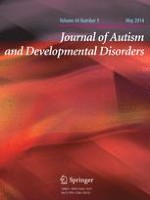01-05-2014 | Original Paper
Restricted and Repetitive Behaviors in Autism Spectrum Disorders and Typical Development: Cross-Sectional and Longitudinal Comparisons
Gepubliceerd in: Journal of Autism and Developmental Disorders | Uitgave 5/2014
Log in om toegang te krijgenAbstract
Restricted and repetitive behaviors (RRBs) are characteristic of autism spectrum disorders (ASD). However, compared to social and communicative impairments, less is known about their development, trajectory and etiology. This study explored RRBs in young children with ASD matched to typically developing (TD) children on non-verbal development. RRBs were coded from direct observation at three time points within 13 months of development. Children with ASD displayed higher frequency and greater diversity of RRBs at all time points, however RRBs were not unique to ASD and evident in the TD control group albeit at a reduced frequency. RRBs did not correlate with social and communicative impairments in the ASD group, suggesting dissociation between these domains.
